Are you looking for a Microsoft 70-332 exam questions? Are you looking for Microsoft 70-332 exam sample questions to identify gaps in your knowledge that may hurt you on the exam? GreatExam is your best choice! We are committed on providing you with the latest and most accurate 70-332 exam preparation material.
QUESTION 1
You are configuring SharePoint 2013 to support business intelligence.
You need to install PowerPivot for SharePoint.
What should you do?
A. Download and install PowerPivot for SharePoint from the PowerPivot SQL Server 2008 R2 SP1 Feature Pack webpage.
B. Run the SQL Server 2008 setup package.
C. Download and install PowerPivot for SharePoint from the PowerPivot SQL Server 2012 Feature Pack webpage.
D. Download and install PowerPivot for SharePoint from the PowerPivot SQL Server 2012 SP1 Feature Pack webpage.
Answer: D
Explanation:
https://technet.microsoft.com/en-us/library/dn456880.aspx
QUESTION 2
You are configuring a SharePoint farm.
You have the following requirements:
– Implement an enterprise resource pool.
– Enable tasks to be assigned to users.
– Implement a resource breakdown structure.
You need to implement a solution that meets the requirements.
What should you do?
A. Create a SharePoint team site.
B. Provision a Microsoft Project web app.
C. Create a SharePoint task list.
D. Import a Microsoft Excel spreadsheet as a custom list.
Answer: B
QUESTION 3
You are implementing a claims-based authentication solution for a SharePoint farm in an Active Directory Domain Services domain.
You install and configure Active Directory Federation Services (AD FS).
You need to ensure that all web applications in the farm support SAML-based claims authentication.
What should you do? (Each correct answer presents part of the solution. Choose all that apply.)
A. Configure AD FS with the web application as a relying party.
B. Configure web applications to use forms-based authentication and AD FS as the trusted identity provider.
C. Configure web applications to use claims-based authentication and AD FS as the trusted identity provider
D. Configure web applications to use classic mode authentication and AD FS as the trusted identity provider.
E. Configure SharePoint to trust AD FS as an identity provider.
Answer: ACE
Explanation:
Configure SAML-based claims authentication with AD FS in SharePoint 2013.
This configuration has the following phases that must be performed in consecutive order:
Phase 1: Install and configure an AD FS server
(A) Phase 2: Configure AD FS with the web application as a relying party
(E) Phase 3: Configure SharePoint 2013 to trust AD FS as an identity provider
(C) Phase 4: Configure web applications to use claims-based authentication and AD FS as the trusted identity provider
Reference: Configure SAML-based claims authentication with AD FS in SharePoint 2013
QUESTION 4
You are moving a customized SharePoint site collection to a new farm.
You attach and mount the source content database in the destination farm.
You need to ensure that all customizations from the source farm are available in the destination farm.
What should you do?
A. Install all custom applications in the destination farm.
B. Copy all custom master pages from the source site collection to the Style Library in the destination site collection.
C. Copy all SharePoint groups and users from the source farm to the destination farm.
D. Copy all custom master pages from the source site collection to the master page gallery in the
destination site collection.
Answer: A
QUESTION 5
An organization upgrades a SharePoint 2010 environment to SharePoint 2013.
A site collection is running in SharePoint 2010 compatibility mode.
You must verify that the following features will function correctly when the site collection is upgraded to SharePoint 2013 native mode:
– List views
– Custom web parts
– Content query web parts
– Subsites
You need to ensure that you can perform verification testing without impacting the current user experience.
What should you do?
A. Upgrade the site collection to SharePoint 2013.
B. Perform a database attach upgrade.
C. Enable the Visual Upgrade option for the site collection.
D. Generate an upgrade evaluation site collection.
Answer: D
QUESTION 6
Drag and Drop Question
A company plans to upgrade from a SharePoint Server 2010 farm to a SharePoint Server 2013 farm.
You plan to install components that are required on the new farm before upgrading.
You need to identify the customizations that must be installed on the new farm.
Which command should you run? (To answer, drag the appropriate command and switch to the correct locations in the answer area.)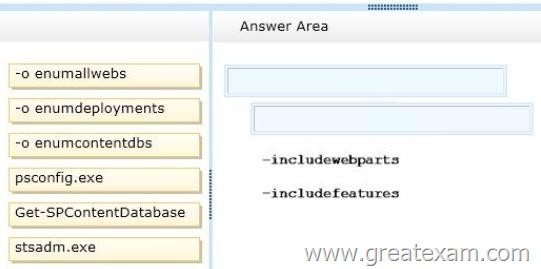
Answer: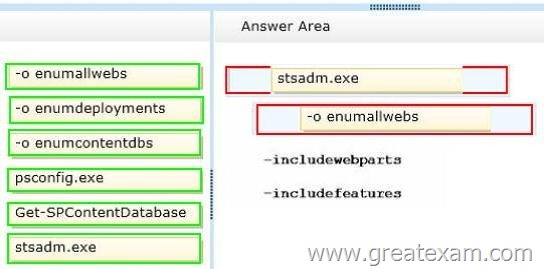
Explanation:
Identify all server-side customizations and install them before you upgrade One common error during upgrade is missing server-side files — either files that were installed with SharePoint 2010 Products or customized files. When you prepared for upgrade, you should have created an inventory of the server-side customizations (such as site definitions, templates, features, Web Parts, assemblies) that your sites required. Check this inventory to make sure that all the files that are needed for your customizations are installed in your new environment.
You can use the enumallwebs operation in Stsadm.exe to identify server-side customizations that are being used.
QUESTION 7
Drag and Drop Question
An organization migrates a SharePoint environment from SharePoint 2010 to SharePoint 2013. The organization has a web application at http://intranet.contoso.com. A corporate governance policy states that users of the web application must be able to create sites only with a compatibility level of SharePoint 2013.
You need to implement the governance policy.
Which three Windows PowerShell cmdlets should you run in sequence? (To answer, move the appropriate cmdlets from the list of cmdlets to the answer area and arrange them in the correct order.)
Answer: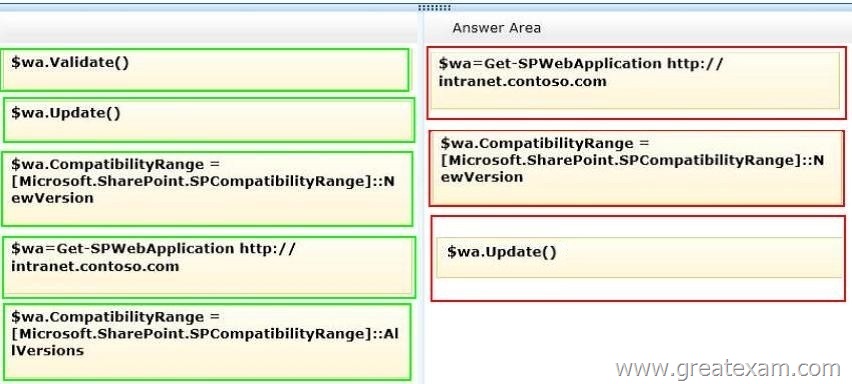
Explanation:
* RangeName is one of the following values:
OldVersions, NewVersion, AllVersions.
Here we must NewVerssion as ” the web application must be able to create sites only with a compatibility level of SharePoint 2013″.
* The last step is to validate.
* At the Windows PowerShell command prompt, type the following command to change the compatibility range settings to a specific range:
$wa=Get-SPWebApplication <URL>
# Stores the web application at that URL as a variable $wa.CompatibilityRange = [Microsoft.SharePoint.SPCompatibilityRange]::<RangeName> # Specifies which range to use
$wa.Update()
# Updates the CompatibilityRange setting to use only the range you specified $wa.CompatibilityRange
# Returns the new CompatibilityRange for the web application Where:
<URL> is URL for the web application that you want to change. RangeName is one of the following values: OldVersions, NewVersion, AllVersions.
Reference: To change compatibility range for site creation modes for a web application by using Windows PowerShell
QUESTION 8
A SharePoint 2010 environment contains a Microsoft SQL Server 2008 R2 database instance named SP-SQL that hosts the databases for the farm.
You are upgrading the farm to SharePoint 2013.
You need to ensure that users can access the unmodified farm contents during the upgrade process.
What should you do?
A. In SQL Server Management Studio, locate the SQL Server instance containing the content databases and service application databases you plan to upgrade.
Set the Instance Read-Only value to True.
B. Run the following Transact-SQL (T-SQL) statement for each content database and service application you plan to upgrade.
ALTER DATABASE <database name>SET READ_ONLY;
C. Run the following command-line tool for each site collection in the content databases you plan to upgrade.
Stsadm -o setsitelock -urKsite collection name> -lock readonly
D. Sign in to Central Administration in the SharePoint 2010 environment you plan to upgrade.
Set each content database and service application database to Read-Only.
Answer: B
Explanation:
Set the previous version databases to be read-only
If you want your original environment to remain available to users in a read-only state, set the databases to read-only before you back them up.
Complete this step for each content database in your environment. Depending on your organization, you might need a database administrator to complete this step.
Incorrect:
Not A: The content databases, not the server instance, should be set to Read-only.
Note:
* To set content databases to be read-only
1. Verify that you have the following administrative credentials: You must be a member of the db_ownerfixed database role in each database.
2. Open SQL Server Management Studio.
3. Right-click the content database that you want to change to read-only, and then click Properties.
4. Select the Options page, and, in the Other options list, scroll to the State section.
5. In the Database Read-Only row, click the arrow next to False, select True, and then click OK.
6. Repeat for all other content databases.
* A farm is considered to be read-only if any of the following are true:
/All content databases are set to read-only.
/Service application databases are set to read-only.
QUESTION 9
Drag and Drop Question
You are preparing to upgrade from a SharePoint 2010 environment to a SharePoint 2013 environment. The SharePoint 2010 environment includes a large number of content databases. You restore backups of the content databases to the Microsoft SQL Server instance in the SharePoint 2013 environment.
You need to upgrade all content databases and minimize monitoring requirements.
What should you do? (To answer, drag the appropriate terms to the correct location or locations in the answer area. Each term may be used once, more than once, or not at all. You may need to drag the split bar between panes or scroll to view content.)
Answer:
Explanation:
* To attach a content database to a web application by using Windows PowerShell Start the SharePoint 2013 Management Shell.
At the Windows PowerShell command prompt, type the following command and then press ENTER:
Mount-SPContentDatabase -Name DatabaseName -DatabaseServer ServerName – WebApplication URL
* Attach the remaining databases (no need to wait until first command finishes and use new instance)
After you restore the first content database and verify success, you can continue to restore and upgrade other databases. You can perform parallel database attach upgrades to upgrade more than one database at a time. Use separate Command Prompt windows (i.e new instance) to run multiple upgrades. It is recommended that you separate the start time for each new database upgrade session by several minutes to prevent issues with temporary locks set for the web application during attachment. Otherwise you might receive an error on the upgrade session. The wait time to clear temporary locks varies depending on the number of site collections, or the speed of the database server hardware.
Reference: Upgrade content databases to SharePoint
QUESTION 10
Drag and Drop Question
An organization plans to deploy Microsoft Project Server 2013.
You need to install and configure Project Server in an existing SharePoint farm.
Which four actions should you perform in sequence? (To answer, move the appropriate actions from the list of actions to the answer area and arrange them in the correct order.)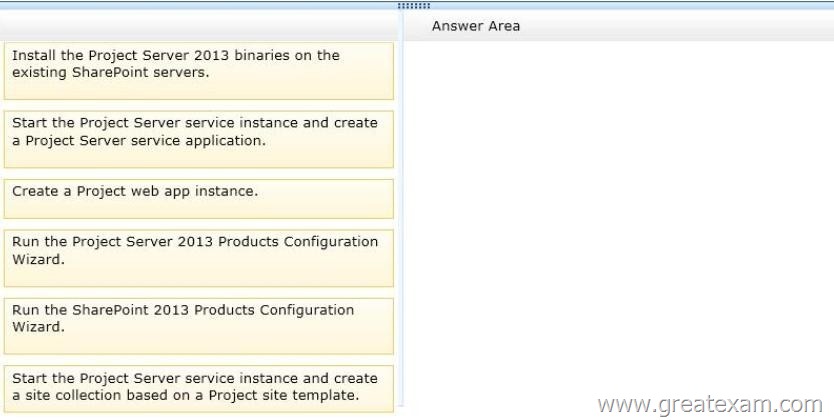
Answer: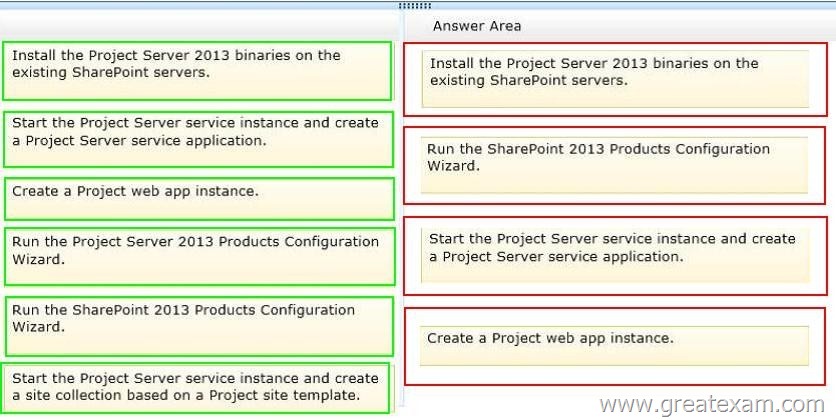
Explanation:
* (step 1) If you already installed and configured SharePoint Server 2013 and you would like to try out Project Server 2013 features there’s no need to install another SharePoint server.
You can simply integrate between Project Server 2013 and SharePoint Server 2013 using an existing site collection.
Project Server 2013 runs as a service application under SharePoint Server 2013. In order to integrate between those products, Project Server 2013must be installed on each application server in your SharePoint farm.
Reference: Add an application server to a farm in Project Server 2013
* (step 2) First thing that has to be done after installing Project Server 2013 is to run the SharePoint Products Configuration Wizard. The wizard has to run on all application servers in your farm before you can start using Project Server.
* (step 3) Start the Project Server Application Service. Create a Project Server service application. Open SharePoint 2013 Central Administration – > Application Management -> Manage service applications -> New -> Project Server Service Application.
Specify a name for the service application and choose an application pool.
* (step 4)
Create a Project Web App database. Open the SharePoint 2013 Management Shell and Use the following PowerShell cmdlet: New-SPProjectDatabase -Name DatabaseName – ServiceApplication “ServiceApplicationName” -DatabaseServer SQLServerInstance -Tag String. For example: New-SPProjectDatabase -Name ProjectWebApp1 -ServiceApplication “ProjectServiceApp ” -DatabaseServer sp2013srv -Tag “ProjectWebApp1DB” Reference: How to integrate Project Server 2013 with SharePoint Server 2013
QUESTION 11
Drag and Drop Question
You have a custom solution named SalesSolutron deployed to the URL http://site.contoso.com/sites/sales.
You need to deploy a new version of the solution without retracting the previous version.
How should you complete the Windows PowerShell cmdlet? (To answer, drag the appropriate terms to the correct location or locations in the answer area. Each term may be used once, more than once, or not at all. You may need to drag the split bar between panes or scroll to view content.)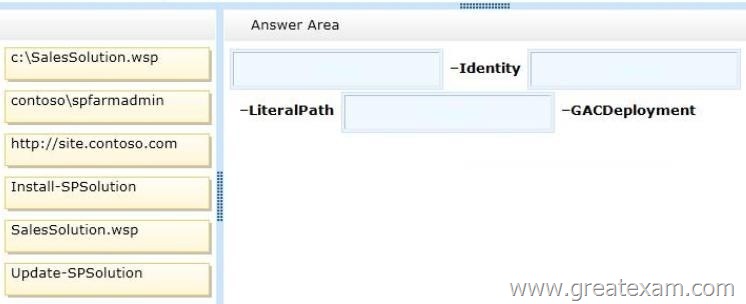
Answer: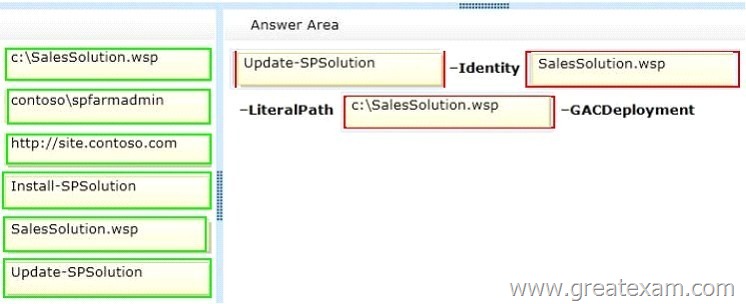
Explanation:
*(box 1) The Update-SPSolution cmdlet upgrades a deployed SharePoint solution in the farm. Use this cmdlet only if a new solution contains the same set of files and features as the deployed solution.
Syntax:
Update-SPSolution [-Identity] <SPSolutionPipeBind> -LiteralPath <String> [-AssignmentCollection <SPAssignmentCollection>] [-CASPolicies <SwitchParameter>] [-Confirm [<SwitchParameter>]] [- Force <SwitchParameter>] [-FullTrustBinDeployment <SwitchParameter>] [-GACDeployment <SwitchParameter>] [-Local <SwitchParameter>] [-Time <String>] [-WhatIf [<SwitchParameter>]]
*(box 2) Identity Required Specifies the SharePoint solution to deploy.
* (box 3) LiteralPath Required
Specifies the path to the solution package.
The type must be a valid path in either of the following forms:
– C:\folder_name
– \\server_name\folder_name
QUESTION 12
Hotspot Question
You install Microsoft Project Server 2013.
You need to provision a Project web app instance in an existing web app in a SharePoint farm.
In Central Administration, which task should you perform? (To answer, select the appropriate task in the answer area.)
Answer:
Explanation:
You can provision a Service Application Framework service application in the following ways:
Using Evaluation Mode for installations
Using the Farm Configuration Wizard
–> Using the Manage Service Applications user interface (UI) Using Windows PowerShell
Reference: SharePoint 2013, Provisioning Service Applications
QUESTION 13
You are configuring a SharePoint farm in an environment that includes Microsoft Exchange Server 2013. You need to ensure that specified SharePoint users can search the Exchange mailboxes of all employees, place holds on mailbox data, and export mailbox data. What should you do first?
A. Create an external content type for Exchange mailbox information.
B. Configure server-to-server authentication between SharePoint and Exchange.
C. Create an external list for Exchange mailbox information.
D. Configure forms-based authentication between SharePoint and Exchange.
Answer: B
QUESTION 14
A company has a SharePoint environment that contains multiple site collections.
The company purchases an app.
You need to ensure that the app is available in all site collections.
Which Windows PowerShell cmdlets should you run?
A. Install-SPApp and then Update-SPAppCatalogSettings
B. Import-SPAppPackage and then Install-SPApp
C. Import-SPAppPackage and then Enable-SPAppAutoProvision
D. Enable-SPAppAutoProvision and then Install-SPApp
Answer: B
QUESTION 15
An organization is using SharePoint for team collaboration.
Each department in the organization has a team site and a site owner who is responsible for site management. Site owners do not have administrative rights to the web servers.
You need to ensure that site owners can install trusted apps to their own sites.
What should you do?
A. Create a sandbox solution.
B. Grant the site owners the Full Control permission level to the web applications.
C. Configure solution blocking settings.
D. Configure content deployment settings.
E. Create an App Catalog site.
Answer: E
QUESTION 16
Hotspot Question
You are designing a SharePoint search solution.
The search solution must meet the following requirements:
– Run search queries against specific SharePoint columns.
– Run search queries against specific document properties.
You need to ensure the search solution meets the requirements.
What should you do? (To answer, select the appropriate option from each drop-down list in the answer area.)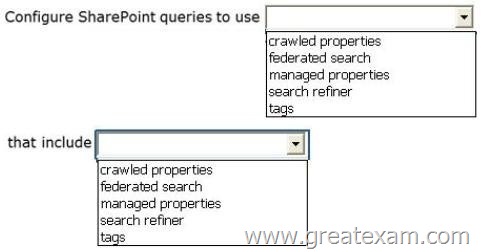
Answer: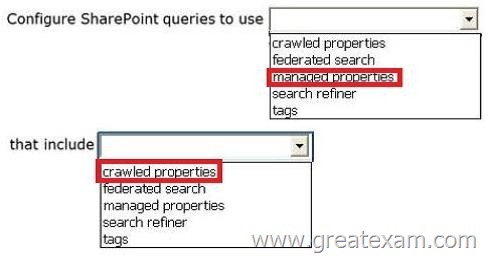
Explanation:
* To include the content and metadata of crawled properties in the search index, you map crawled properties to managed properties.
* A crawled property is content and metadata that is extracted from an item, such as a document or a URL, during a crawl. A crawled property can be an author, title, or subject. To include the content and metadata of crawled properties in the search index, you map crawled properties to managed properties. Managed properties can have a large number of settings, or attributes. These attributes determine how the contents are shown in search results. The search schema contains the attributes on managed properties and the mapping between crawled properties and managed properties.
QUESTION 17
Drag and Drop Question
An organization is involved in a legal case related to one of its products.
All documents related to this product are stored in a subsite of a site collection. The site collection has an existing policy to delete documents that have not been modified for four years.
You must protect the data that is relevant to the case without impacting other content, changing file locations, or duplicating files.
You need to configure SharePoint to ensure that relevant documents are NOT deleted by existing or future expiration policies.
Which three actions should you perform in sequence? (To answer, move the appropriate actions from the list of actions to the answer area and arrange them in the correct order.)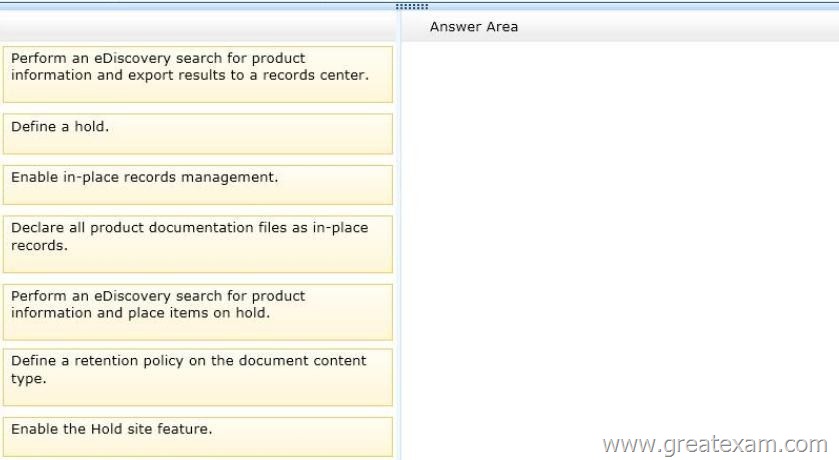
Answer: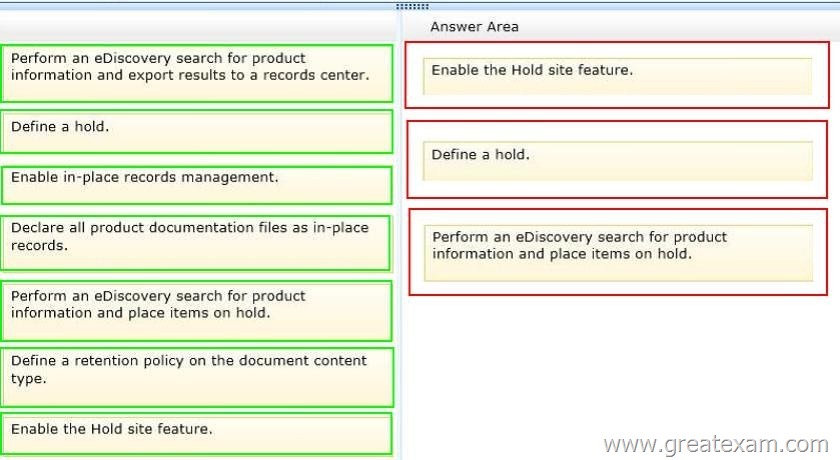
Explanation:
Box 1: Enable the Hold site feature.
Box 2: Define a hold.
Box 3: Perform an eDiscovery search for product information and place items on hold.
Note:
* An in-place hold is a mechanism for placing content (SharePoint 2013 documents, list items, pages, and Exchange Server 2013 mailboxes) on legal hold while allowing users to continue working with the content and without them being made aware of the hold. If a user edits or deletes content that has been placed on in-place hold, the content is automatically moved to a special location thus preserving the state of the content as it was at the time the hold was placed.
* In-place holds can be placed either at the site or mailbox level, or alternatively, you can use query- based preservation. With query-based preservation, you can define eDiscovery search queries and only content that matches your query will be preserved.
* eDiscovery, or electronic discovery, is the process of discovering (finding) electronically stored information that is relevant to legal matters such as litigation, audits and investigations. Though it is called eDiscovery, the process typically entails more than just the discovery. The main stages of the process are roughly:
1. Discovery – Find the relevant content
2. Preservation – Place content on legal hold to prevent data destruction
3. Collection – Collect and send relevant content to be processed
4. Processing – Prepare files to be loaded into a document review platform
5. Review – Attorneys determine which content will be provided to opposition
6. Production – Provide relevant content to opposition The SharePoint 2013 eDiscovery functionality focusses on the first three stages.
* Site holds
SharePoint preserves content on the site level. When you preserve a site, its lists, libraries, and subsites are preserved. If you preserve a root site collection, all documents, pages, lists, and subsites in that site collection are preserved.
To hold a site, create a Discovery Case in the eDiscovery Center. A case is a container for all of the queries, content, and preservations associated with specific litigation. After you create the case, create a Discovery Set to specify the site. To validate the site, just enter its URL address.
QUESTION 18
Drag and Drop Question
An organization uses SharePoint Server collaboration sites for all projects. Each project has a unique site. Project team members have Contribute permission levels to each project site of which they are members. Sites for completed projects must meet the following requirements:
– The project team members must be able to access files.
– They must be prohibited from editing or deleting files.
– They must not be able to change site permissions.
You need to configure the SharePoint environment to meet the requirements. Which three actions should you perform in sequence? (To answer, move the appropriate actions from the list of actions to the answer area and arrange them in the correct order.)
Answer: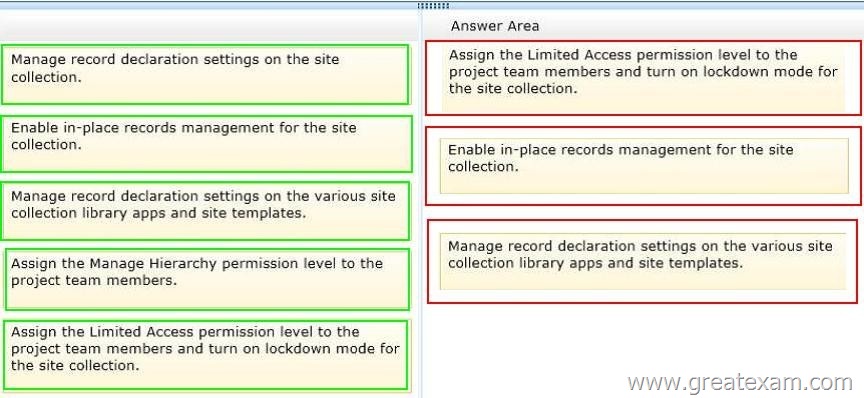
Explanation:
* The Records Center was introduced in 2007 as a SharePoint site that served as a conventional records archive. Content from all over the enterprise can be submitted to a Records Center and then routed to the appropriate place where it picks up the right permissions and policies, such as expiration and auditing.
You must have the Manage Permissions permission to configure site permissions. In SharePoint Server, by default only the Full Control and Manage Hierarchy permission levels include this permission.
QUESTION 19
Hotspot Question
An organization is deploying a SharePoint farm that will provide a records-management solution. Users must be able to perform the following actions:
– Create in-place holds on content stored in SharePoint and in Microsoft Exchange 2013.
– Search for content and place holds based on the search query.
You need to create a site collection that meets the requirements.
Which type of site collection should you create? (To answer, select the appropriate template in the answer area.)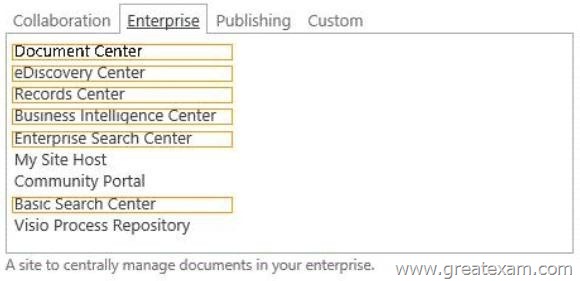
Answer: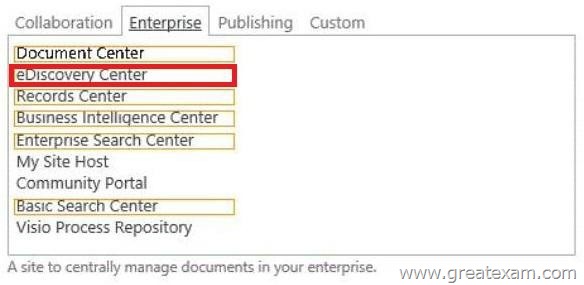
Explanation:
* Site holds
SharePoint preserves content on the site level. When you preserve a site, its lists, libraries, and subsites are preserved. If you preserve a root site collection, all documents, pages, lists, and subsites in that site collection are preserved.
To hold a site, create a Discovery Case in the eDiscovery Center. A case is a container for all of the queries, content, and preservations associated with specific litigation. After you create the case, create a Discovery Set to specify the site. To validate the site, just enter its URL address.
QUESTION 20
Drag and Drop Question
An organization has a SharePoint intranet site. Documents and other files do not currently appear in search results until the day after they are uploaded to the intranet site.
You need to configure the Search service application to ensure that documents appear in search results within one hour of being uploaded to the site.
Which three actions should you perform in sequence? (To answer, move the appropriate actions from the list of actions to the answer area and arrange them in the correct order.)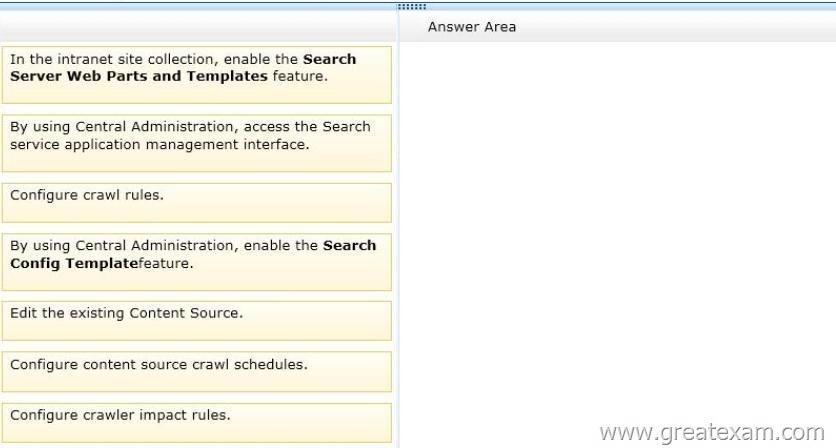
Answer: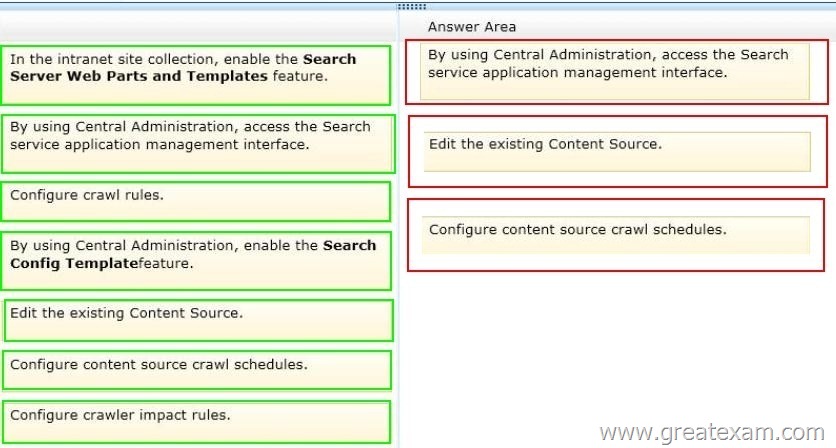
Explanation:
Box 1: By using Central Administration, access the Search Service application management interface.
Box 2: Edit the existing Content Source
Box 3: Configure content source crawl schedules.
(Step 1) 1. Open Central Administration web site.
2. Click on the Manage service applications link
3. Click on the Search Service Application
(Step 2) 4. Click on the Content Sources link
(Step 3) 5. Click on the Local SharePoint sites cell and in the page on the right side you can see the Crawl Schedules.
You can see two item: Full Crawl and Incremental Crawl Reference: SharePoint 2010
Create Crawl Schedule
Our 70-332 dumps are rich in variety. We offer 70-332 PDF dumps, 70-332 practice test and 70-332 VCE dumps. We ensure you can pass the 70-332 easily. Welcome to GreatExam.com.